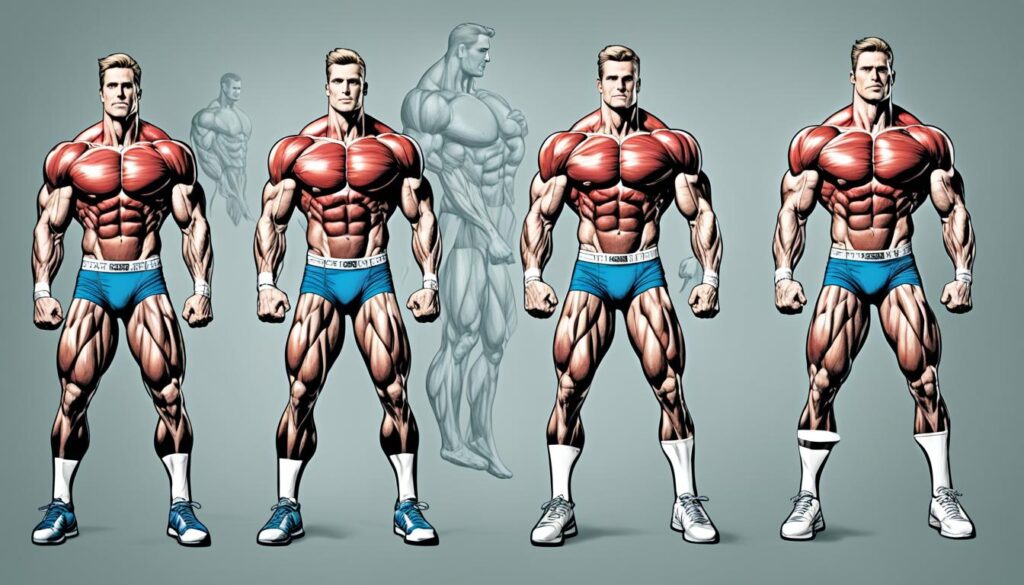Beginner’s Guide: what do hip thrusts work
Did you know that the gluteus maximus, our largest buttock muscle, is often underutilized and weak in many individuals? This surprising fact highlights the importance of incorporating hip thrusts into your workout routine. Hip thrusts are not only a popular exercise, but they also have a significant impact on targeting and strengthening the glutes and other lower body muscles.
Key Takeaways:
- Hip thrusts target the gluteus maximus, the largest muscle in the buttocks.
- Incorporating hip thrusts into your routine can improve lower body strength and performance.
- They also engage other muscles in the lower body, such as the hamstrings and quadriceps.
- Hip thrusts provide a stable movement pattern that minimizes strain on the back and knees.
- Adding hip thrusts to your workouts can lead to noticeable improvements in muscle activation and athletic performance.
Understanding Hip Thrusts and Their Benefits
Before diving into the specific muscles targeted by hip thrusts, let’s first understand what hip thrusts are and why they are beneficial.
Hip thrusts are a compound exercise that primarily focuses on the glutes, but they also engage other muscles in the lower body including the hamstrings, quads, and core.
Incorporating hip thrusts into your workout routine can lead to increased strength, power, and functional performance. This exercise is especially popular among fitness enthusiasts and athletes due to its ability to effectively activate and develop the glute muscles.
Hip thrusts involve elevating the hips using a bench or stable surface. The movement requires pushing the hips upward while maintaining a straight line from the shoulders to the knees. By utilizing the glutes and other muscles in the lower body, hip thrusts effectively improve overall lower body strength, stability, and muscular development.
One of the notable benefits of hip thrusts is their ability to directly target and activate the gluteal muscles. The gluteus maximus, which is the largest muscle in the buttocks, is the primary muscle involved in the movement. By specifically targeting this muscle, hip thrusts can lead to enhanced glute strength and size.
In addition to targeting the glutes, hip thrusts also engage other muscles in the lower body. The hamstrings, located at the back of the thighs, and the quadriceps, located at the front of the thighs, are both utilized during the exercise. This engagement of multiple muscle groups makes hip thrusts a beneficial compound exercise for overall lower body development.
Adding hip thrusts to your workout routine can offer numerous benefits, including:
1. Increased Lower Body Strength:
Hip thrusts target the glutes, hamstrings, and quads, providing a comprehensive lower body workout. The progressive overload achieved through hip thrusts can lead to increased strength and muscle development in these muscle groups.
2. Power and Explosiveness:
By focusing on the posterior chain, hip thrusts can enhance power and explosiveness in movements such as running, jumping, and lifting. Strengthening the glutes and hamstrings through this exercise can lead to improved performance in sports and daily activities that require explosive lower body movements.
3. Core Stability:
While hip thrusts primarily target the glutes, they also require core engagement to maintain stability throughout the movement. This results in improved core strength and stability, which are essential for overall functional fitness.
In conclusion, hip thrusts are a versatile exercise that provides numerous benefits for individuals looking to enhance their lower body strength, power, and overall performance. By targeting the glutes and engaging other muscles in the lower body, hip thrusts offer a comprehensive workout that can yield noticeable results with consistent practice.
Take advantage of the benefits of hip thrusts by incorporating them into your workout routine and unlock the potential of your lower body!
Muscles Targeted by Hip Thrusts
Hip thrusts are a highly effective exercise for targeting and strengthening specific muscles in the lower body. In particular, hip thrusts primarily target the gluteus maximus, which is the largest muscle in the buttocks. By performing hip thrusts, you can activate and engage the gluteus maximus to build both strength and size in this crucial area.
Additionally, hip thrusts also activate the hamstrings and quadriceps to a lesser degree. These muscles play a complementary role in hip extension and knee stabilization during the exercise. Therefore, incorporating hip thrusts into your workout routine can contribute to comprehensive lower body muscle development.
| Muscles Targeted | Primary Activation | Secondary Activation |
|---|---|---|
| Gluteus Maximus | High | Low |
| Hamstrings | Low | Moderate |
| Quadriceps | Low | Moderate |
By engaging multiple muscle groups simultaneously, hip thrusts help create a well-rounded lower body strength and stability. Strengthening these muscle groups can have a positive impact on your overall athletic performance and everyday movements, such as walking, running, and jumping.

Maximizing Glute Activation
If you want to maximize glute activation during hip thrusts, it is essential to ensure proper form. Here are a few key tips to focus on:
- Position your feet hip-width apart and firmly on the ground.
- Place a barbell or resistance band just above your hips.
- Engage your core and squeeze your glutes as you lift your hips towards the ceiling.
- Avoid hyperextending your lower back at the top of the movement.
- Control the descent and repeat for the desired number of repetitions.
By maintaining proper form and concentrating on engaging the glutes throughout the exercise, you can optimize the benefits of hip thrusts and achieve the best results for your lower body muscles.
Importance of Hip Thrusts for Beginners
Hip thrusts are a fantastic exercise for beginners who want to strengthen their lower body and build a solid foundation of leg strength. This exercise provides a stable movement pattern that targets specific muscles, while minimizing strain on the back and knees. By incorporating hip thrusts into your workout routine, you can improve muscle activation and enhance overall athleticism.
When it comes to leg strength, hip thrusts are a must-try exercise. By focusing on the glutes, hamstrings, and quadriceps, hip thrusts provide a comprehensive workout that targets multiple muscle groups simultaneously. This compound exercise helps to build both strength and size in the lower body, leading to noticeable improvements in lower body performance.
One of the reasons why hip thrusts are ideal for beginners is the controlled and stable movement pattern they offer. Unlike some other leg exercises that may put excessive strain on the back or knees, hip thrusts allow beginners to safely engage their leg muscles without compromising their form.
Integrating hip thrusts into your routine can also enhance overall athleticism. The leg strength developed through hip thrusts translates into improved performance in various sports and activities. Whether you’re a runner, a weightlifter, or simply someone who wants to move well, hip thrusts can help you develop the leg strength necessary for optimal performance.
To ensure you get the most out of your hip thrusts, it’s important to focus on proper form and gradually progress in terms of weight and intensity. This will help you avoid injuries and maximize the benefits of this exercise.
In conclusion, hip thrusts are an essential exercise for beginners seeking to strengthen their lower body and improve muscle activation. By targeting key muscle groups like the glutes, hamstrings, and quadriceps, hip thrusts provide a stable and effective movement pattern that yields significant improvements in leg strength and performance.
Start incorporating hip thrusts into your workout routine today and experience the benefits for yourself!
Benefits of Hip Thrusts for Beginners
| Benefits | Description |
|---|---|
| Strengthen lower body | Hip thrusts target the glutes, hamstrings, and quadriceps, leading to improved leg strength. |
| Minimize strain on back and knees | The controlled movement pattern of hip thrusts reduces the risk of strain on the back and knees, making it suitable for beginners. |
| Improve muscle activation | By incorporating hip thrusts into your routine, you can enhance muscle activation in the lower body. |
| Enhance athleticism | The leg strength developed through hip thrusts translates into improved performance in various sports and activities. |
Conclusion
Hip thrusts are an effective exercise for beginners seeking to enhance their lower body strength, muscle activation, and overall performance. By targeting the glutes, as well as engaging other muscles in the lower body, hip thrusts provide a comprehensive workout that yields noticeable results.
Whether you’re a beginner or an experienced lifter, adding hip thrusts to your routine can contribute to a balanced physique and improved athletic performance. These exercises not only help to build strength in the glutes but also activate the hamstrings, quads, and core, resulting in a well-rounded lower body muscle development.
Start incorporating hip thrusts into your workouts and experience the benefits for yourself. With proper form and gradual progression, you can expect to see improvements in lower body performance and overall muscle activation. Achieve your fitness goals with the power of hip thrusts!
FAQ
What are hip thrusts?
Hip thrusts are a compound exercise that primarily focuses on the glutes. They involve lifting the hips off the ground, using a barbell or other weight, to target and strengthen the muscles in the lower body.
Why are hip thrusts beneficial?
Hip thrusts are beneficial because they engage multiple muscles in the lower body, including the glutes, hamstrings, quads, and core. By incorporating hip thrusts into your workout routine, you can improve lower body strength, power, and functional performance.
Which muscles are targeted by hip thrusts?
The primary muscle targeted by hip thrusts is the gluteus maximus, which is the largest muscle in the buttocks. Additionally, hip thrusts also activate the hamstrings and quadriceps to a lesser degree, contributing to overall lower body muscle development.
Why are hip thrusts important for beginners?
Hip thrusts are important for beginners because they provide a stable movement pattern that targets specific muscles while minimizing strain on the back and knees. By incorporating hip thrusts into your routine, you can build leg strength, improve muscle activation, and enhance overall athleticism.
